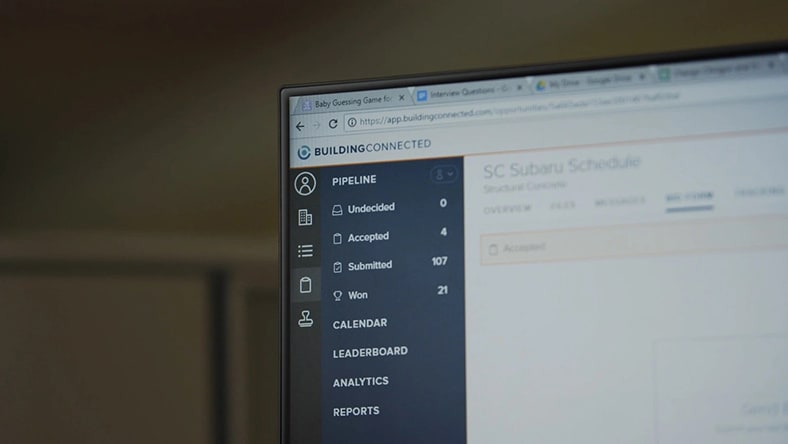& Construction

Integrated BIM tools, including Revit, AutoCAD, and Civil 3D
& Manufacturing

Professional CAD/CAM tools built on Inventor and AutoCAD
The tender process in construction invites bids or proposals from contractors to undertake a project, including steps like issuing an invitation, bid submission, evaluation, and contract award. The goal is selecting a qualified contractor based on criteria such as cost, experience, and compliance with project specifications, ensuring a transparent and competitive selection process.
The project's scope can influence the form of the tendering process.
The tendering process can take many forms depending on the scope and complexity of the project and the client’s risk tolerance.
Open tendering: An open tender is accessible to the public and any interested contractor can submit a bid. It is suitable for projects in which a wide pool of contractors can meet the project requirements and the client aims for maximum competition.
Selective tendering: In selective tendering, only pre-qualified or shortlisted contractors are invited to submit bids. The selection is based on contractors’ qualifications, experience, and capabilities.
Negotiated tendering: Negotiated tendering involves direct negotiations between the client and one or more selected contractors. The client negotiates terms and conditions, including price, with the chosen contractor(s).
Serial tendering: Serial tendering divides a larger project into smaller packages or phases. Contractors bid on individual packages or phases and separate contracts are awarded for each.
Framework tendering: Framework tendering establishes a framework agreement with selected contractors. Instead of bidding for individual projects, contractors compete for a position on the framework and contracts are then awarded as projects arise. Project owners often opt for framework tendering when they’re looking to build long-term relationships with a group of contractors for ongoing and future projects.
Single-stage tendering: In single-stage tendering, the design and construction phases are combined into a single tender. Contractors submit a complete bid, including detailed design and pricing. This approach is usually adopted for straightforward projects with well-defined requirements where a single contractor can manage design and construction.
Two-stage tendering: Two-stage tendering separates the design and construction phases. In the first stage, contractors submit initial bids based on outline designs. The client then selects a preferred bidder and detailed design and pricing are finalized in the second stage.
The project owner and potential contractors use the structured bidding process to navigate from the beginning through the construction phase.
From the moment a project owner notifies potential contractors that they’re open to bids through beginning the construction phase, there’s a method to the bidding process both sides need to pay attention to, namely:
Invitation: The process begins with the client (project owner) issuing an invitation to tender. This formal document outlines project details, specifications, requirements, and instructions for submitting bids. The invitation may include a request for pre-qualification, asking potential bidders to provide information about their qualifications, experience, and financial stability.
Clarification: After the invitation is issued, there is typically a clarification period during which potential bidders can seek clarification on any aspects of the tender documents. The client responds to queries to ensure that all bidders have a clear understanding of the project requirements, specifications, and other relevant details.
Submission: Bidders prepare and submit their sealed bids or proposals before the specified deadline. Bids typically include details such as cost estimates, project timelines, technical specifications, and any other information required by the client.
Evaluation: The client opens the submitted bids in a transparent manner, often in the presence of representatives from the participating companies. The submitted bids are evaluated based on predefined criteria, which may include cost, technical capabilities, experience, and compliance with specifications. Note: Some projects may involve a negotiation phase where the client and shortlisted bidders discuss terms before finalizing the contract.
Settlement: After the evaluation, the client selects the winning bidder and formally awards the contract.
Contract execution: Once the settlement is reached, the client and the winning bidder(s) sign a formal contract that states all agreed-upon terms and conditions and outlines the responsibilities of both parties. A kick-off meeting may be conducted to initiate the project, clarify expectations, and establish communication channels.
Tender management software serves a single source of truth where contractors can generate, submit, and track their bids through the tendering lifecycle. Project owners can use it to narrow down invites to the right contractors, manage proposals, and ensure they’re awarding the best bids.
A tender management software tool like Autodesk BuildingConnected helps streamline the entire bid and tender process, from the creation of requests for proposals (RFPs) to the submission and evaluation of bids.
Software-enabled bid evaluation tools can help project owners compare contractors by experience, quoted cost, technical specifications, and compliance, narrowing down candidates to find the best-fit firms.
Preconstruction platforms can also be used to accurately forecast the cost of a project to avoid underbidding or overshooting the project owner’s budget.
A cloud-based bid management tool acts as a single hub where general contractors can manage bid invites, keep tabs on who’s working on what (i.e., among their team of subcontractors), and track due dates across the entire project.
From the project owner’s perspective, bid management software can be used to automatically qualify (or disqualify) contractors by measuring your project against their risk profile, including metrics such as their largest completed project, total value of uncompleted projects, revenues, and net cash flow.
TradeTapp automates subcontractor qualification with comprehensive tools for faster and more accurate reviews.
BuildingConnected provides collaboration for owners and builders on the largest construction network, to simplify bid management and qualification.
Powerful BIM and CAD tools for designers, engineers, and contractors, including Revit, AutoCAD, Civil 3D, Autodesk Forma, and more
Here’s a snapshot of how project owners and contractors are using Autodesk’s suite of tools to send out more bids, manage the tender process, and filter through to find the best offer.
WZW CONSTRUCTION
Learn how Autodesk BuildingConnected helped a Sydney-based developer ditch its spreadsheets and switch to managing subcontractor tender responses from one source of truth.
BOWMAN FLOORING
Before switching to Autodesk’s Bid Board Pro, this flooring was growing so fast it would lose bids due to poor tracking capabilities. Replaced email and Excel workflows helped increase their tender win rates and annual revenues by 25% and $9 million.
BRADLEY CONCRETE
Learn how one company increased revenues from $3 million to $42 million annually by adopting Autodesk’s Bid Board Pro and BuildingConnected to draft and send out bids faster and keep tabs on tenders.
Browse select resources on construction tendering and how to navigate it.
Learn how Autodesk’s suite of tools can help you combine technology, process, and people to transform the tendering process, automate manual work, and encourage adoption across your workforce.
An Autodesk University masterclass designed to guide contractors through navigating tender stages, integrating customer requirements, slashing tender time by up to 50%, and building 3D contextual models for added effect.
A detailed guide for contractors learning how to bid for construction projects that explains how to pick the right projects, draft winning bids, follow up, and deconstruct why your bids may be falling flat.
The construction bidding process can be broken down into roughly four stages: bid solicitation (i.e., requests for proposals), submission, evaluation and selection, and contract negotiations.
A tender is a formal bid for a construction project made by an interested contractor, usually in response to a request by the project owner.
The tendering process includes four key stages:
The tender period refers to the duration during which contractors or suppliers are invited to submit their bids or proposals in response to a tender invitation for a particular project.





